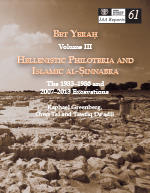Citation:

Abstract:
This, the third and final volume of reports dedicated to the publication of the 1933–1986 excavations at Khirbat al-Karak (Kh. Kerak)/Tel Bet Yeraḥ, describes the contiguous Hellenistic and Early Islamic remains excavated in the northern and southern parts of the site. These form an important component in the history of occupation on the mound and make a significant contribution to the archaeology of both periods. Their identification at the site in fact predates that of the Bronze Age remains: Eleazar Sukenik, who was asked to visit the road cut through ‘the Kerak’ in 1921, was the first to note their existence (Sukenik 1922), and the first to posit the identification of the site with Philoteria (see Chapter 2).
Substantial Hellenistic remains have been found, by several excavators, in virtually every part of the mound (Plan 1.1; Tables 1.1, 1.2): in all the areas excavated along its southern side (Areas BS, MS/EY, MK, GE), along considerable parts of the last Early Bronze Age fortification line (Wall C, principally in Towers 5, 8, 11 and 14 and near the ‘sortie tunnel’ [C10]) and in the various excavations of the northern sector (Areas GB, DK). In the central part of the mound, evidence is spotty, with the more substantial remains in Areas AC and BH, pits only in Areas UN and RV, and few finds reported in soundings undertaken by Delougaz and Haines in the western part of the mound. This distribution might indicate a bimodal concentration of houses on the two higher portions of the mound in the north and south, with the intervening saddle being, perhaps, only sporadically occupied (Table 1.2).
Earlier considerations of Hellenistic Philoteria, based for the most part on the sketchy preliminary publications of the excavation and on chance finds such as a cache of silver tetradrachms attributed to the site (Baramki 1944) and the later Tyche presumably found in the road cut (Sukenik 1922), had asserted the existence of a fortified town occupying the entire mound (Negev 1976; Hestrin 1993). The attribution of the fortifications (EB III Wall C, described in BY I: Chapter 6) to the Hellenistic period rested both on Hellenistic finds made by Bar-Adon within several towers and the assumption that round towers should be ascribed, by default, a Hellenistic date. However, the most recent considerations of the latest stone fortifications, by Getzov (2006) and by Greenberg et al. (BY I), supply evidence for an original Early Bronze Age date for Wall C, as well as for the presence of Hellenistic burials in or near the fortifications that imply that at least parts of the wall were considered to be separate from the settlement. The recent work of the Tel Aviv University team (Greenberg and Paz 2010) has allowed us to observe site formation processes in various parts of the mound. These observations suggest that when Hellenistic settlers first arrived at the site, most of which had been abandoned for two millennia, they found not the gently undulating surface of the modern mound, but an uneven surface pockmarked with ruins and with prominent stone foundations of fortifications and of monumental structures. The main concentrations of houses were built away from the massive earlier remains, which were used for refuse disposal and possibly for crafts such as potting (a large pit with kiln fragments was excavated in the Early Bronze Age Circles Building in 2009).
Post-Hellenistic presence on Tel Bet Yeraḥ was quite limited in extent and did not produce massive deposits. Early excavators reported Roman remains, but virtually nothing of this period can be identified in the remaining collections. Byzantine occupation appears to be limited to the church excavated and published by Delougaz and Haines (1960). The same excavators also identified substantial Early Islamic construction above the church; this was associated with the historical Umayyad palatial site of al-Ṣinnabra, although it was generally thought that the palace itself was located north of the mound.
